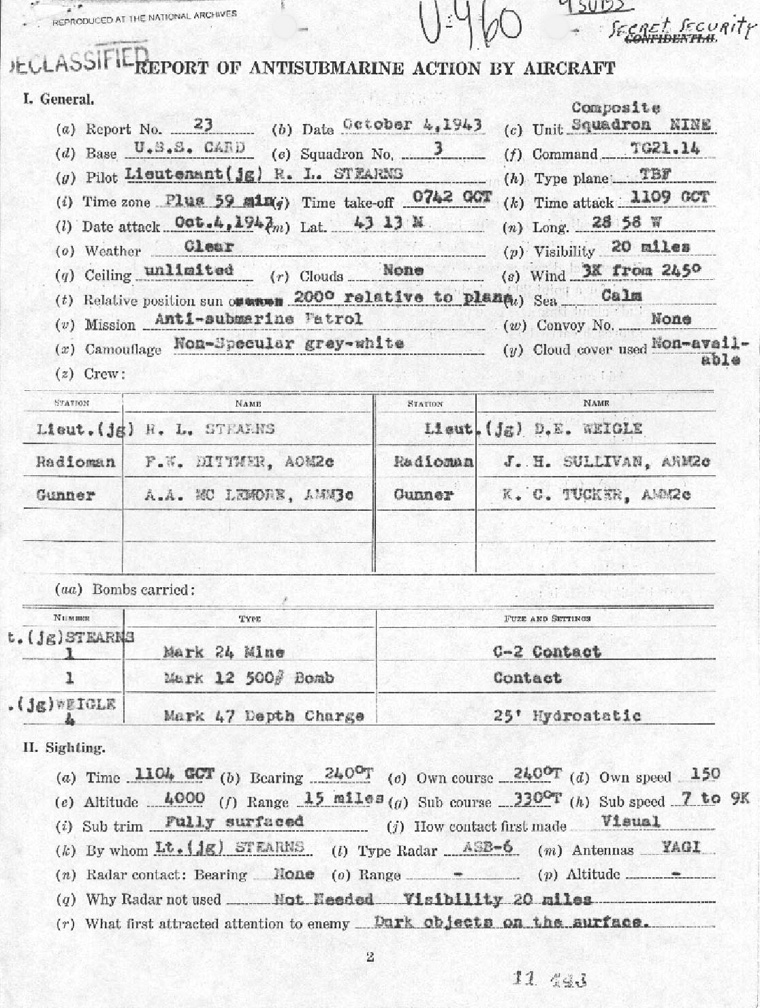

| SECRET SECURITY | ||
| IV(K) Description of U/B. | ||
| Unfortunately due to the number of the U/Bs present, and the intense AA fire they were throwing up, it was impossible to get very close to them during the early stages of the engagement before the fighters arrived. It was therefore, impossible to observe the smaller U/B, which was the first to dive, in much detail. | ||
| It was, however, believed to have been a 740 Ton Type, as it seemed rather large, except in comparison to the other three, all of which were extremely large, and all about the same size. It was by comparison, about three-quarters as long (estimated lengths 225' and 300 '), and much more narrow abeam than the other three. | ||
| The other three U/Bs all appeared very much alike. They were all, apparently, exactly the same size. No guns were observed on deck, either forward or aft, on the last two larger U/Bs to dive, though the other had one deck gun forward. | ||
| One however, was definitely a Fueler, as it was most apparent, on sighting that the 740 Tonner was taking on fuel, (and possibly also supplies), due to its proximity to the other, and the line or hose connecting the two. | ||
| The main difference between the Fueler and the other two was their conning towers. | ||
| The Fueler's conning tower was drum-shaped, being almost completely round with all sides vertical. It was not stepped-down aft, as had no basket or gun platforms. | ||
| The conning towers of the other two larger U/Bs were tear-shaped, pinched in at the center, and quite long and narrow, and, therefore, appeared to be relatively low. They were stepped-down just aft of the pinched-in part, in two stages, making two baskets, the after one lower than the one forward. | ||
| The AA guns were housed in the baskets aft of the conning tower. No estimates of the number of guns was ventured by anyone present, but all were unanimous in their belief that there were many more guns than they had previously believed the U/Bs carried. Lt.(jg) Stearns, who has been under heavy fire before, on several occasions, said the number of guns was far beyond the number he had ever seen before. Whenever the guns would fire, the entire conning tower was almost completely covered with heavy white smoke. | ||
| At no time was anyone observed on deck or in the conning towers manning any guns. This leads to the belief that they were in protected mounts, or possibly turrets, but no one saw any positive evidence of this. In fact, no one ever saw an AA gun itself, merely the smoke, caused by their firing, was observed. | ||
| Lt.(jg) Stearns who has already seen ten enemy submarines said he never saw a U/B as big as any of these three before, in spite of the large Fueler he sighted and helped sink 12 June 1943. (See ASW-6 Report #19, 12 June 1943, also photographs ACV-9, #190, 191, 192, 194). The one submarine which most nearly compared to these, according to Lt.(jg) Stearns, was the one attacked by planes of this squadron, while on the USS BOGUE on 8 June 1943. (See ASW-6 Report #16, photograph ACV-9, #189). | ||
| Paragraph IV, (P); | ||
| Surface indication Left by Submarine: | ||
| Large amount of heavy oil and debris of all kinds rose to the surface. | ||
| Three large steel cylindrical objects about 1 to 2 feet in diameter were seen on the surface. They floated in a vertical position so no accurate estimate can be made of their length but they could be seen extending quite a way beneath the surface. One pilot said they seemed to taper off toward the submerged end and looked somewhat like torpedoes. The tops were rounded and extended about 2 or 3 feet above the surface. They appeared to have a small dark knob, or perhaps a handle, on the end. Two of the pilots said their shape was exactly like the small CO2 bottles that fit in the "Mae West" lifejackets. One pilot thought they were big enough to hold a man and he thought they were escape mechanisms. It is thought that they may have been unarmed torpedoes. They were still seen floating five hours later, but were not seen the next day. One interesting thing about these is that they did not come to the surface for fully 60 seconds after the mine had exploded, and then they popped up directly in the mine's slick. This would seem to eliminate the possibility of any forward motion on the part of the submarine after the explosion. | ||
| There was also another white object floating on the water which pilots felt was a life raft of some sort. It was white and looked like a Franklin buoy. It was about 6'x8'. | ||
| There were also a great many small bits of wreckage and several larger pieces of planking, some of which was painted red. | ||
| A large cork-ring-type life raft was also seen among the debris. It had a solid bottom and was about 6'x15'. About a 2" line was attached to one end of it which acted as a sea anchor as it did not appear to move. Lieutenant (junior grade) Stearns feels this is the raft that was being towed behind the fueler, when he first saw them. | ||